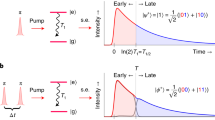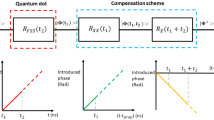Abstract
We have reported triggered photon-pair emission from single quantum dots that is suggestive of polarization entanglement1. Gilchrist et al.2 criticize our analysis of the density matrix, claiming that the entanglement test is inappropriate. However, we show here that this analysis is in fact valid for an unpolarized source such as ours, and that this analysis (as well as alternative measures of entanglement) suggests that quantum-dot sources do emit entangled photons, and that their quality is rapidly improving3.
This is a preview of subscription content, access via your institution
Access options
Subscribe to this journal
Receive 51 print issues and online access
$199.00 per year
only $3.90 per issue
Buy this article
- Purchase on Springer Link
- Instant access to full article PDF
Prices may be subject to local taxes which are calculated during checkout

Similar content being viewed by others
References
Stevenson, R. M. et al. Nature 439, 179–182 (2006).
Gilchrist, A., Resch, K. J. & White, A. G. Nature 445, doi: 10.1038/nature05546 (2007).
Young, R. J. et al. N. J. Physics 8, 29 (2006).
Edamatsu, K., Oohata, G., Shimizu, R. & Itoh, T. Nature 431, 167–170 (2004).
Author information
Authors and Affiliations
Corresponding author
Rights and permissions
About this article
Cite this article
Stevenson, R., Young, R., Atkinson, P. et al. Source of triggered entangled photon pairs? (Reply). Nature 445, E5–E6 (2007). https://doi.org/10.1038/nature05547
Published:
Issue Date:
DOI: https://doi.org/10.1038/nature05547
Comments
By submitting a comment you agree to abide by our Terms and Community Guidelines. If you find something abusive or that does not comply with our terms or guidelines please flag it as inappropriate.



